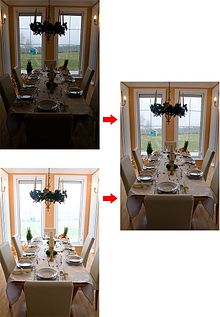Exposure fusion
As exposure fusion ( Exposure fusion ), exposure blend ( exposure blending ), contrast ratio increase ( Dynamic Range Increase, DRI ), or pseudo-HDR be in digital image processing refers to methods by having different exposure times recorded still images of the same subject ( AEB ) as a single image to combine so that overexposed and underexposed areas are largely avoided and more details are retained. Exposure fusion is a pure method of image processing in which the dynamic range of the image is not increased; the term "contrast range increase" or "DRI" is therefore misleading.
Differentiation from HDR photography
Exposure fusion pursues similar goals as HDR photography (see also HDRI generation from exposure series ), but is technically more simply structured. No temporary HDR images are generated which then have to be converted back into representable images using tone mapping . This simplified process is generally faster than the generation of HDR images with subsequent tone mapping and, with suitable methods, achieves a comparable quality.
Procedure
With manual exposure fusion, the individual images of the exposure series are combined with a standard image processing program , whereby the lightest areas of an image are replaced by the corresponding areas from the next darker image, see adjacent image.
Algorithms have been developed with which the manual process described above can be automated and improved. These automatic procedures consist of two sub-steps:
- Step 1: Recognize the correctly exposed parts of the image in each image of the exposure series.
- Step 2: Combine these image parts into an overall image, which then essentially only consists of the correctly exposed image parts of the individual partial images.
Technically closely related to exposure fusion is the focus stacking process . In focus stacking, a different criterion is used in step 1 to determine the image parts to be used, but the combination of the individual image parts (step 2) takes place in the same way.
literature
Individual evidence
- ↑ a b See for example Tom Mertens, Jan Kautz, Frank van Reeth: Exposure Fusion. In Proceedings of Pacific Graphics 2007, pp. 382-390. IEEE, Piscataway (NJ) 2007, ISBN 0-7695-3009-5 ( Online ( Memento of the original from October 31, 2011 in the Internet Archive ) Info: The archive link has been inserted automatically and has not yet been checked. Please check the original and archive link accordingly Instructions and then remove this notice. )
- ↑ Exposure Blending Guide for Photoshop
- ↑ Exposure Blending Guide for GIMP
- ↑ Photoshop Tutorials Video Instructions
- ↑ a b Enfuse user manual (PDF; 937 kB)

